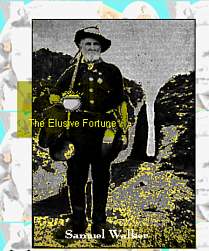|
|

"Ever
since Mnemosyne, the mother of the muses, gave the wax tablet to
mortals, memory, writing and technology have been interconnected.
"

All thumbnails link to larger, high quality versions of Califia's illustrations. All images are from M. D. Coverley's Califia (Eastgate Systems, in press). Reproduced by permission of Eastgate Systems. 
|
Three-Dimensional
Dementia 8 Like Violet's incomprehensible song, Willing Stars' embroidered hieroglyphics are the last echoes of words spoken in the private language of an extinct people. Both of their voices fall on near-deaf ears and it is only with Augusta, Kaye and Calvin's unraveling of secrets that Violet and Willing Stars' meanings and messages emerge from the apparent trappings of non-sense. Just as Augusta had not noticed the embroidery on the blue blanket, so she initially misreads Violet's attempt to communicate:
Privileging a women's community and oral forms of storytelling, Califia undertakes a rediscovery of what has been forgotten in the present and reclaims the beauty in non-conceptual ways of knowing. Positing an ongoing grail quest for meaning and direction, the text re-creates a world where an elusive treasure of the constellations of connections are the ideal, but where linguistic ruptures, quakes and fissures are necessary for growth and changing perceptions. Just as the California landscape is constantly rewritten by earthquakes and landslides, and functions as a literal and figurative container of forgotten memories in Califia, so "Our memories" like the text "are always in the process of revision" (North: Night of the Bear, Introduction). 1 | 2 | 3 | 4 | 5 | 6 | 7 | 8 | Sources _____ Specializing in the twentieth century feminist avant-garde, hypertext and the technologies of writing, Carolyn Guertin is a Doctoral Candidate (ABD) and SSHRC Doctoral Fellow at the University of Alberta, Canada. A poet as well as a scholar, her work is widely published in print and online. Her hypertexts have appeared in BeeHive and the Electronic Book Review, and she is Curator of Assemblage: The Women's Hypertext Gallery at the trAce Online Writing Community, (selections of which are featured in Marjorie C. Luesebrink's Progressive Dinner Party in this issue.) This is her debut (as a Contributing Editor as well) in Riding the Meridian. "Three-Dimensional Dementia" was originally presented in a slightly different form at the Digital Arts and Culture (DAC '99) Conference, Georgia Institute of Technology, October 1999, with the generous assistance of The Sarah Nettie Christie Bursary and the Mary Louise Imrie Graduate Student Award both from the University of Alberta. M.D. Coverley is the pen name of Marjorie C. Luesebrink, M.F.A. She teaches writing at Irvine Valley College and has been making hypermedia fiction since 1995. Her interactive, hypertext novel, Califia, is forthcoming from Eastgate Systems on CD-ROM in 2000. Recent short fictions on the web include: "Endless Suburbs" (Iowa Review Web), "Life in the Chocolate Mountains" (Salt Hill #7), "The Lacemaker" (in the The Book of Hours of Madame de Lafayette produced by Christy Sheffield Sanford), "Pao Lien and the Cave Dragon, Wu" (the trAce Millennium Project) and "Fibonacci's Daughter" (forthcoming in New River).
|
||
